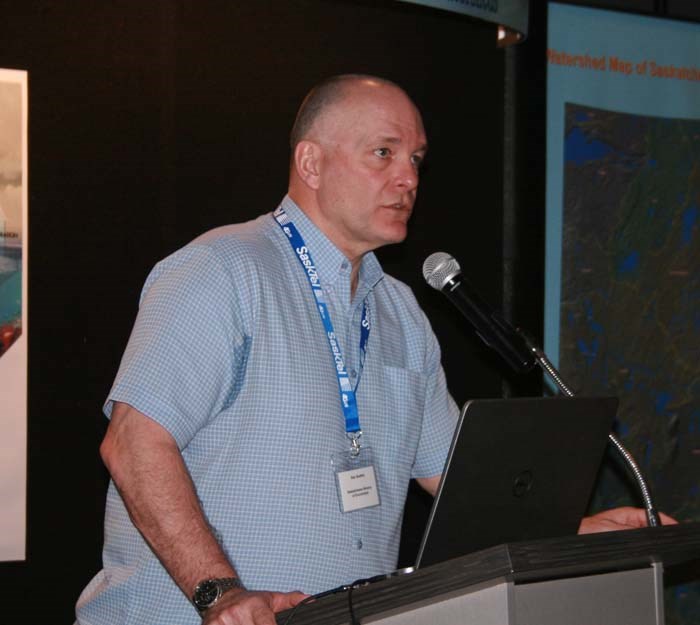Welcome to Week CCV of ‘Fishing Parkland Shorelines’. Like most of us I am a novice fisherman, loving to fish, but far from an expert. In the following weeks I’ll attempt to give those anglers who love to fish but just don’t have access to a boat, a look at some of the options in the Yorkton area where you can fish from shore, and hopefully catch some fish.
Not surprisingly when the Saskatchewan Association of Watersheds held its annual conference in Yorkton last week fish were on the agenda.
In general terms the SAW Conference is an opportunity for those involved in local watershed authorities to meet on a provincial scale to discuss source water protection and management issues. It also provides an opportunity for members and stakeholders to share information and learn from each other’s successes and challenges.
While the event includes SAW’s annual meeting, most of the conference focuses on a series of speakers, this year focusing on the theme of the role water plays in industry in Saskatchewan.
That included Bob Skaftfeld with the Fish and Wildlife Branch under the Saskatchewan Ministry of Environment speaking about the 2010 Saskatchewan Fisheries Study.
The Survey is part of a national initiative, with the province mailing them out to licensed anglers, and the federal government being responsible for doing the actual work in terms of compiling the data.
The survey provides a look at angler numbered, the amount of time they spent on the water, the number iof fish they catch, harvest and the money they spend in the effort Skaftfeld explained.
The 2010 survey was sent to 4100 resident anglers, 1400 Canadian resident anglers and 1400 non-resident angler, with about 45 per cent returned, which was among the highest rates among Canadian provinces, and is very good in term of surveys of its kind, he said.
The survey was also carried out in 2005 and that provided a comparative for Skaftfeld’s presentation.
And the 2015 Surbey of Recreational Fishing in Canada has been sent out.
In 2005 there were 198,000 anglers in Saskatchewan according to the survey. It grew by 13 per cent by 2010 to 224,000.
“That’s anglers who actually fished,” said Skaftfeld, however it is a number that is not able to track anglers 16 and under, or 65-plus, since they are not required to purchase a license in Saskatchewan. He added in terms of seniors, they have not been required to hold a license since 2008.
Eighty-one per net of anglers are from Saskatchewan.
When it comes to other Canadian anglers visiting Saskatchewan to fish, 82 per cent come from Alberta.
Skaftfeld said while Alberta has some great trout fishing, anglers often cross the border to go after walleye, pike and perch.
Most anglers are male at 70 per cent.
Interestingly, anglers do not spend a great number of days pursuing the hobby on average, with just under 12 days a year reported in 2005, and just over 12 days a year in 2010. The increase in time on the water grew by a modest six per cent.
That said, anglers hook into a pile of fish while on the water. In 2005 it was reported to be 8 million, and in 2010 that was up 20 per cent to 9.6 million.
“There was more anglers, spending more time with better tech … Tech seems to just improve, improve, and improve,” said Skaftfeld.
Of the fish caught 94 per cent where walleye, pike and perch.
“That picture hasn’t changed much since 2005,” said Skaftfeld.
With more anglers, there are also more fish being kept, in fact 19 per cent more. In 2005 it was 2.4 million, and in 2010 2.8 million.
“That’s a concern for us. It puts more pressure on us and watersheds,” said Skaftfeld.
Given the theme of the SAW Conference, the economics of angling was of prime interest.
A Saskatchewan angler spends just shy of $50 per day when fishing. A Canadian visitor spends $105 per day, and the non-resident $282.
“There is money being spent,” said Skaftfeld.
In 2005, the money spent wholly on the activity of angling was $216 million, but that grew by 28 per cent in 2010 to $302 million.
And now for some stats you may not want to share with a non-fishing spouse.
Every fish we bring home to enjoy fried in butter and herbs is rather costly.
The survey suggested a per fish kept cost for Saskatchewan resident anglers of just shy of $40.
A non-resident Canadian sees that cost per fish jump to $85, and non-resident visitors it’s $189.
In spite of the cost per fish kept, anglers are generally satisfied with the fishing experience in Saskatchewan, said Skaftfeld. In 2005, 67 per cent rated the experience good to excellent, while that grew to 71 per cent in 2010.
And that brings us to 2015, and the survey that is in random angler hands now.
It is the ninth in a series of surveys carried out every five years since 1975, through the cooperative efforts of the Department of Fisheries and Oceans (DFO) and the provincial and territorial fisheries management agencies.
“Your feedback is essential for the management of recreational fisheries in Saskatchewan and for understanding its social and economic importance. Even if you fished very little or not at all, your feedback is important,” notes the actual survey, which can be filed online this time around.
So if you received a survey, check it out and help build a database those involved in managing the resource can use to better ensure our fishing future.




